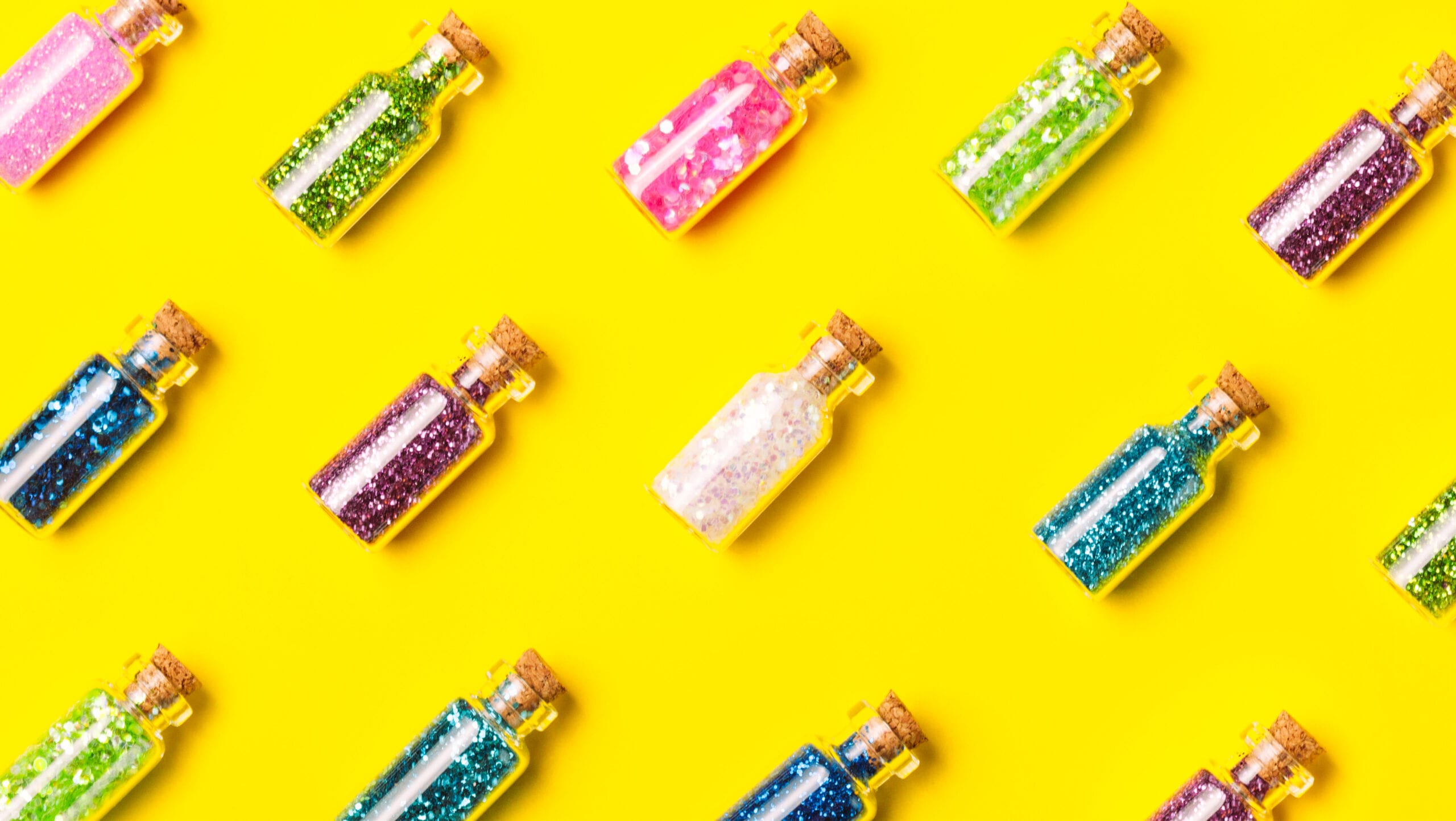When Tala Chebib began performing as her queer burlesque alter ego Moonshine Sunshine two years ago, she knew her numbers had to be eco-conscious. Chebib, 28, had already devoted herself to living green. She ate locally, used eco-friendly products at home and tried to buy second hand whenever possible. She wanted to approach burlesque with the same rules in mind.
“Performance in general is very wasteful,” Chebib says. “I saw it as a challenge to be able to perform without waste, and hoped to show others that beautiful things can be made without having harm the environment.”
Chebib made nearly all her costumes and props out of recycled and secondhand materials, and ensured that when she did buy something new it was ethically sourced. One of the products she eventually invested in was biodegradable glitter. Chebib knew the most common form of glitter, sparkles, were a form microplastic—pieces of plastic less than five millimetres in length. Given that some sources estimate there are up to 51 trillion pieces of microplastic polluting our oceans already, she didn’t want to contribute further.
Glitter may be a ubiquitous queer staple—prominent features in our cosmetics, clothes and party decorations. But Chebib wishes LGBTQ2 communities would adopt smarter consumer habits when it comes to the sparkly stuff.
She isn’t the only one advocating for a change in the way we consume glitter. As concerns about its impact on our waterways grows, so does the backlash toward our favourite shimmery accent.

In 2016, The Atlantic lauded glitter as “an ingenious tool of protest” (remember the wave of anti-gay politicians being hit by “glitter bombs”?). But by 2019, it had been demoted to “the ultimate supervillain of the craft and makeup world,” according to CNN. “Use it once, and you’ll be vacuuming it out of the carpet and picking it from under your nails until the day you die,” the article reads.
In the U.K., several music festivals have prohibited the shimmery substance, while British department store chain Marks and Spencer has removed non-recyclable sparkles from its stores. Closer to home, the Richmond Arts Centre in British Columbia banned glitter last year.
The decisions stem from growing concerns about how glitter pollutes our oceans. Cosmetic glitter, which is the variety that’s most likely to wind up getting washed down the drain after a night out, is made up of layers of pigment, aluminum and plastic (more specifically polyethylene terephthalate, or PET). It can take up to 1,000 years for the plastic in some glitters to completely degrade. In that time, scientists say, it can wreak havoc on marine life.
Those scientists, such as New Zealand marine biologist Olga Pantos, are advocating that we refrain from buying glitter altogether. “It really isn’t a big thing for someone not to use it,” Pantos tells me. “It is pretty. But, honestly, who really needs glitter?”
I’m about to argue that I know a significant number of queers who might believe the perfect Euphoria-style glitter tear is a going-out necessity. But Pantos offers a litany of reasons for me to reconsider: It turns out microplastics such as glitter can cause a dizzying list of negative environmental effects.
“No matter how many people comment ‘NEED’ under pictures of the latest shimmery eye shadow, it gets harder and harder to justify that sparkles are strictly necessary”
First of all, the plastics in glitter contain chemicals, which seep into our waterways over time. If they end up in the fish we eat, they end up in our bodies as well.
Second, marine life can easily mistake glitter for a tasty snack (tiny, sparkly particles make for particularly attractive bait). Once ingested, it can cause internal blockages or tears, or lead to a false sense of satiation—making whatever creature swallowed it feel full, but not delivering any nutrients.
Third—and this is where things really get scary—microplastics can act as rafts for small organisms, including microbes. Because plastics are buoyant, these organisms can cowabunga their way to greater distances than they might by hitching a ride on organic material. This, Pantos tells me, means that glitter can pose a literal biosecurity risk, transporting invasive species or pathogens.
Fourth, glitter is able to make it through some wastewater treatment plants, which means it could carry bacteria commonly found in wastewater into the tap water that we drink.
And finally, the plastic in glitter is made from petroleum, which means manufacturing it uses fossil fuels. No matter how many people comment “NEED” under pictures of the latest shimmery eye shadow, it gets harder and harder to justify that sparkles are strictly necessary.

I often perform in drag, and I switched to using a biodegradable cosmetic glitter a couple of years ago. But for anyone who wears makeup or purchases Christmas cards or has thrown even one Pride party, it’s hard to abstain from using glitter altogether. As I write this story, my nails are adorned with a glinting polish, its blue-green sparkles calling to mind the very oceans that it could wreak havoc upon were it to find its way down the drain.
At a time when the world seems to be in a political and environmental tailspin, sometimes we just want to get shiny and have a little fun. So what’s a shimmer-loving queer to do?
Mica, a naturally occurring mineral dust with sparkly properties, might be a solution for queers who want to shine without becoming fish slaughterers. It’s already used in a number of sparkly eyeshadows, but would-be ethical consumers need to be wary of where the product is coming from.
In the past few years, multiple news organizations have reported that the substance is typically derived from illegal mines in India, which employ child labourers. After news of mica’s dark provenance sparked international outrage, some companies went on to find “clean” sources of the mineral, but most remain opaque about their sourcing practices. A 2016 report by the NGOs Terre des Hommes and SOMO found that 25 percent of the world’s mica came from mines in the Indian states of Jharkhand and Bihar. Ninety percent of these mines were illegal, and collectively, they employed more than 20,000 children.
A number of biodegradable glitters have also hit the market in recent years. Several brands have replaced most of the plastic in their products with plant-based cellulose, which can break down much faster than PET. Problem solved, right?
Chebib bought her biodegradable glitter from a vendor in Montreal, where she lives. The product she has is meant to degrade in water and with heat. But Chebib admits the packaging doesn’t specify how much time or what temperature is actually required.
Turns out, this information could matter. “True biodegradable glitters do offer a suitable substitute,” Pantos says. “However, some of them are not environmentally friendly as they claim to be.”
“I switched to using a biodegradable cosmetic glitter a couple of years ago. But for anyone who wears makeup or purchases Christmas cards or has thrown even one Pride party, it’s hard to abstain from using glitter altogether”
If a product is biodegradable in composting facilities, for example, it’s no good. “There is little to no chance people will be collecting up their glitter and sending it to a commercial plant,” Pantos says.
Additionally, no one’s figured out how to manufacture completely plastic-free sparkles—and even cellulose takes time to degrade.
Ronald Britton, one of the U.K.’s largest glitter manufacturers, released its line of Bioglitter back in 2014. Its most shimmery offering, Sparkle, is made from eucalyptus extract and aluminum, and degrades up to 87 percent in fresh water in 28 days. The company hasn’t yet tested the product in ocean water, so its effects on marine life remain unknown.
Nonetheless, biodegradable varieties are a step in the right direction. Glitter that survives in water for a few weeks is bound to do far less damage than glitter that survives for hundreds of years.

While scientists are still gauging exactly how much of an impact glitter can have on our waterways, we already know that sparkles can’t be held uniquely responsible for ruining our oceans.
Every year, 8 million metric tonnes of plastic find their way into our oceans, according to a 2016 study by the World Economic Forum. (That’s equivalent to a garbage truck full of plastic being dumped in the ocean every minute, the report offers as alarming context.) Last year, a plastic bag was found at the deepest point of the ocean—11 kilometres underwater in the Mariana Trench. By 2050, we could have more plastic in the ocean than fish.
“By 2050, we could have more plastic in the ocean than fish”
I might prevent thousands of tiny fragments from becoming boogie boards for underwater microbes by keeping my mug a little less sparkly, but abstaining can almost feel pointless when corporations are producing more than 300 metric tonnes of plastic per year.
While Pantos admits that what we really need is for governments and corporations to adopt strict environmental policies, she urges individuals not to become complacent in their own habits.
“Every little bit helps,” Pantos says. “It’s a lot easier to prevent glitter from getting into the environment by not using it than trying to remove it later on.”
Chebib agrees. She knows it’s impossible to make eco-conscious choices 100 percent of the time. (When I interview her over the phone, she’s taken up a farming gig in the Dominican Republic, which she took a plane to get to.) Still, she believes we all need to pitch in. “I’m not about to shame anyone for wearing glitter now and again,” she says. “But if we were all a little tiny speck more conscious of where our purchases are coming from, what materials we’re using… that will make a huge difference.”


 Why you can trust Xtra
Why you can trust Xtra


